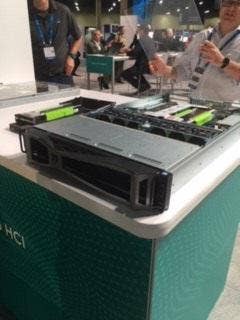NetApp Ties HCI To Data Fabric, Makes It A Platform For On-Prem Private Cloud With Full Public Cloud Capabilities

NetApp on Wednesday introduced new capabilities for its HCI hyper-converged infrastructure platform with an eye on showing how it is an integral part of the company's Data Fabric platform for seamless management of data between on-premises and cloud environments.
NetApp also introduced a new single point of support for its popular FlexPod converged infrastructure platform, a move channel partners said will make it easier to use the platform to provide new services to clients.
The converged and hyper-converged infrastructure expansions were unveiled during day two of the NetApp Insight 2018 conference, held this week in Las Vegas.
[Related: NetApp Insight: NetApp Significantly Expands Ability To Treat On-Premises, Cloud As One]
NetApp created some controversy last year when it introduced its HCI offering because it included separate server and storage nodes while its competitors put compute and storage in the same boxes.
However, there is actually an advantage for the separate nodes, said Brad Anderson, senior vice president and general manager for NetApp's Cloud Infrastructure business unit.
It stems from NetApp's decision to make HCI into an on-premises platform for private clouds that, because of the tie to NetApp Data Fabric, offer the same capabilities and services as public clouds, Anderson told CRN.
NetApp wants customers and partners to start thinking "HCI" stands more for hybrid cloud infrastructure than hyper-converged infrastructure given that it brings software-defined and virtual data center capabilities to commodity hardware in the same way the cloud does," he said.
"With Data Fabric, NetApp is creating new data services like NetApp Kubernates Service or Cloud Volumes," he said. "And anything that can be deployed in the three top hyperscale clouds can also be deployed on HCI."
NetApp's HCI hyper-converged infrastructure appliance was enhanced with a new validated architecture for Red Hat OpenShift containers, and now supports the open source Trident container technology, Anderson said.
HCI now also offers Nvidia GPU support, giving it a strong base on which to run virtual desktop infrastructure or IoT, Anderson told CRN. "It also lays the groundwork for artificial intelligence," he said.
When NetApp demonstrated HCI on Data Fabric, the company showed how easy it is to make it a part of its overall cloud message, said Mark Vaughn, senior director of integrated services at Presidio, a Greenbelt, Md.-based solution provider and longtime NetApp channel partner.
"Now we understand why NetApp was so late to the hyper-converged infrastructure market," he said. "HCI is no so much an on-prem solution. It's an edge solution. It extends the cloud back to the private cloud side of the business."
NetApp is also making a major change in how it manages its FlexPod converged infrastructure offering, built in conjunction with Cisco and VMware, by offering a single point of service for the offering, said Bharat Badrinath, vice president of storage systems and software marketing at NetApp.
"This is one more way for customers to see FlexPod as a single product," Badrinath told CRN. "Today, if a user has an issue, it has to be handed off to the right partner. Now we will be the single hand to shake to make sure the issue is solved."
NetApp also introduced Converged System Advisor to help converged infrastructure look at the entire stack in one console to make FlexPod look more like a single product, he said.
In reality, it is not necessarily confusing to have three points of support for FlexPod, Vaughn said.
"But in reality, FlexPod doesn't feel like a single solution," he said. "NetApp has treated it as a single solution, but with three support numbers. Now it will feel like a single solution."
The new single point of service for FlexPod is very important for clients, said Bob Hankins, vice president of technical sales at Logicalis, a New York-based solution provider and NetApp channel partner.
"We offer FlexPod-based managed services," Hankins said. "Having one support structure is huge for decreasing complexity and increasing serviceability."
This solves a major gripe among customers who see FlexPod as a solution and expected seamless single-provider support, said Glenn Dekhayser, field chief technology officer at Red8, a Costa Mesa, Calif.-based solution provider and longtime NetApp channel partner.
"The challenge to get that working between three companies must have been enormous," he said. "This solves a huge problem, and will accelerate FlexPod sales."
NetApp also introduced a new version of its StorageGRID object storage appliance. The new StorageGRID 6060 adds flash storage to accelerate performance to make it more useful for such workloads as IoT, Badrinath said.
"We see customers wanting to use the Data Fabric," he said. "Customers can tier data between Ontap and StorageGRID, and can do a Fabric Pool between the two."